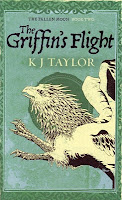You were warned.
Any Other Name opens on the day of Cathy's wedding to Will. She has been drugged by her family to prevent her doing anything crazy, like trying to run away and have a say in her own life. A lot of terrible things happen to Cathy throughout the book (but at least most of them aren't violent!) and I deeply sympathised with her predicament. Although I had hoped at the end of book one that Cathy and Will might realise they have more in common than each saw on the surface of the other, any desire I had to ship them quickly evaporated with Will's behaviour. Made worse, I think, because he often meant well and then utterly failed to do the "right" thing (scare quotes because of generalised moral ambiguity). Really, Cathy was the only Netherworld character in more than two or three scenes that I didn't end up hating for one reason or another. I enjoyed Cathy as a character and there were some promising things set up with her which I look forward to reading about in the next book.
The other major set of characters included Sam, the human who accidentally got caught up in the action in book one, Max, the arbiter, and the sorcerer. Mostly they plod along trying to solve the mass murders and associated issues from book one. There were some interesting revelations, particularly with Sam
The last quarter or so of the book was a bit of an exercise in frustration for me. The reader knows what various factions are up to and then gets to watch as the wrong ones communicate and characters are manipulated into making matters worse. I'm not sure I was entirely in the mood for that kind of heckling-at-the-page-inducing writing, but that was for external reasons. Whether or not that's the sort of thing you like (I generally do) will mean your mileage will vary. (And if you're the kind to exclaim aloud or shake your fist at a book, maybe don't read it on public transport.)
On a non-literary note, I really love the covers for this series. Not only are they attractive (incidentally, it's the same artist as Cassandra Rose Clarke's Assassin's Curse books), but if you look closely you can see a lot of elements that pop up in the books. There's the more obvious things like the flowers and London, but if you look closely, every detail makes sense once you've read the book.
On the whole, this was a solid continuation of the series that brought more or less what I expected (after the slight shock of the opening), and not in a bad way. If you enjoyed Between Two Thorns, I definitely suggest reading Any Other Name. If you didn't, probably give this one a miss. It's also not the kind of sequel that can be read out of order. If you read this whole review without reading the first book, and you're a fantasy fan looking for something a little off the beaten track, I recommend giving this series a go.
4 / 5 stars
First published: June 2013, Angry Robot
Series: yes. Split Worlds, book 2 of 3
Format read: eARC on Kobo
Source: the publisher via NetGalley












































